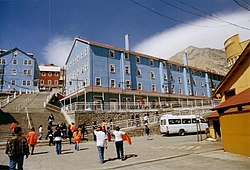Sewell, Chile
| Sewell Mining Town | |
|---|---|
| Name as inscribed on the World Heritage List | |
| Location | Chile |
| Type | Cultural |
| Criteria | ii |
| Reference | 1214 |
| UNESCO region | Latin America and the Caribbean |
| Inscription history | |
| Inscription | 2006 (30th Session) |
Sewell is an uninhabited Chilean mining town located on the slopes of the Andes in the commune of Machalí in Cachapoal Province, Libertador General Bernardo O'Higgins Region, at an altitude of between 2,000 and 2,250 metres.
The town was founded in 1906 by the Braden Copper Company to extract copper from the El Teniente mine. It was named after the company's first president, Barton Sewell.
During the Great Depression, the Braden Copper Company became a subsidiary of Kennecott Copper Company. In 1917 the foundry or smelter was moved from Sewell to [Caletones] which soon also developed a town around it.
Originally male workers lived in shared housing called colectivos. Later family housing was added. Playgrounds, plazas, shops, and a movie theatre later followed. Pedestrians walked up and down vertical staircases. There were unpaved horizontal streets, and no cars. On the west facing side of Cerro Negro a camp for foreign personnel developed.
Ore was taken down the mountainside to Graneros where it was loaded onto railway cars. The narrow gauge railway that connected Sewell to the nearby town of Rancagua began in 1906 and was completed in 1911. Total distance covered was 45 miles with an elevation change of 5,000 feet.
By 1915 Sewell boasted a model hospital, a fire department and a social club. The buildings and homes were made out of timber, and painted bright colors such as yellow, red and blue. At its peak in 1960, more than 16,000 inhabitants called Sewell home. By 1918 the town housed more than 12,000 people.
Sewell is known as the "City of Staircases". The town was built on terrain too steep for wheeled vehicles, around a large central staircase rising from the railway station called the Escalara Central. All supplies had to be brought into the city via a narrow gauge railroad.Pueblo Hundido contained the living quarters while below the ore body was El Establecimiento contained the concentrator, hudroelectric plant, and a tramway.
...
Wikipedia

